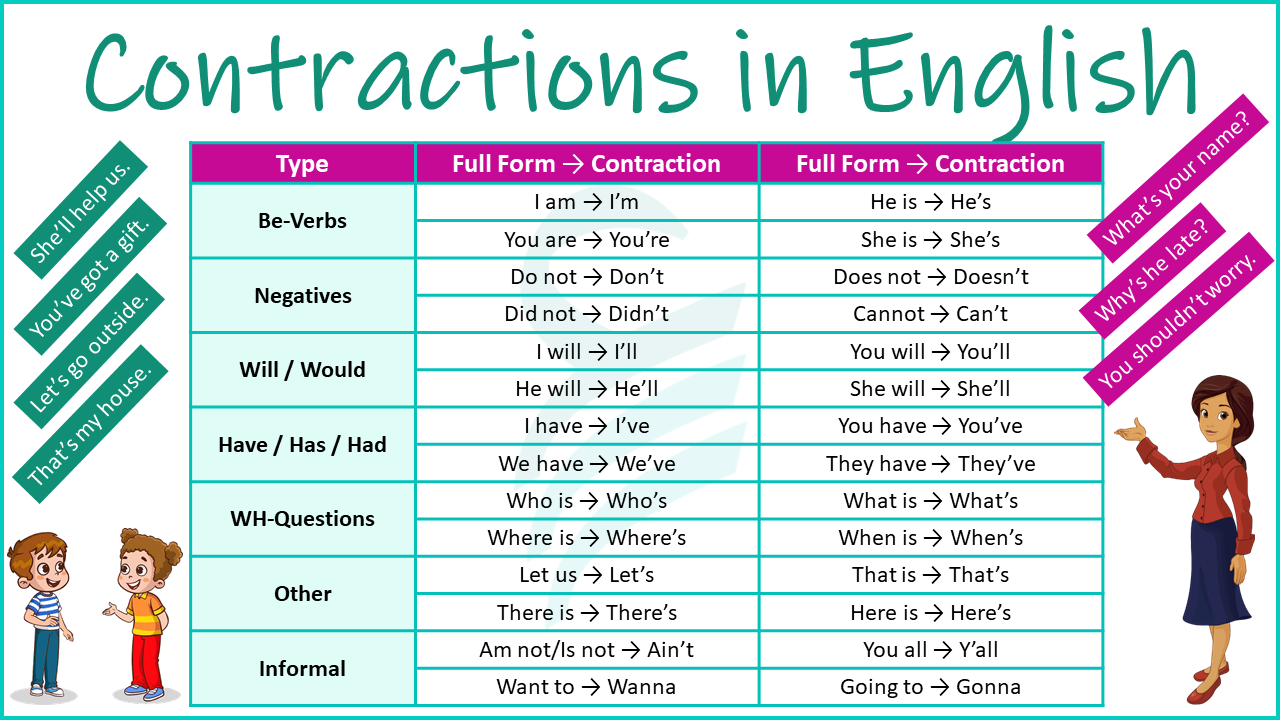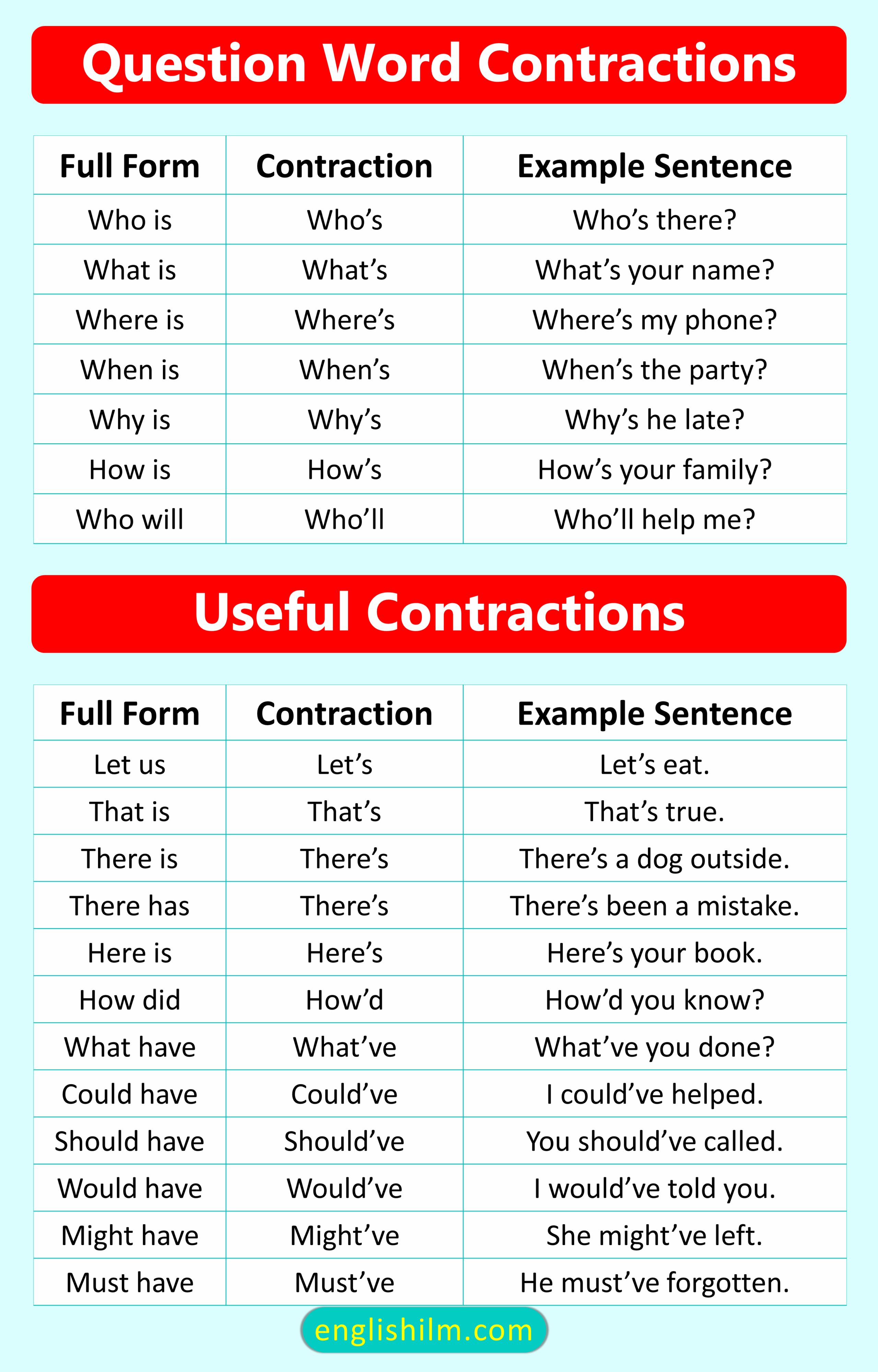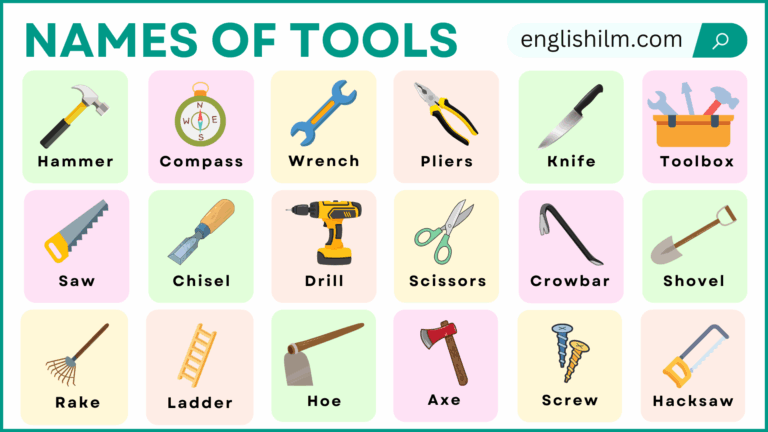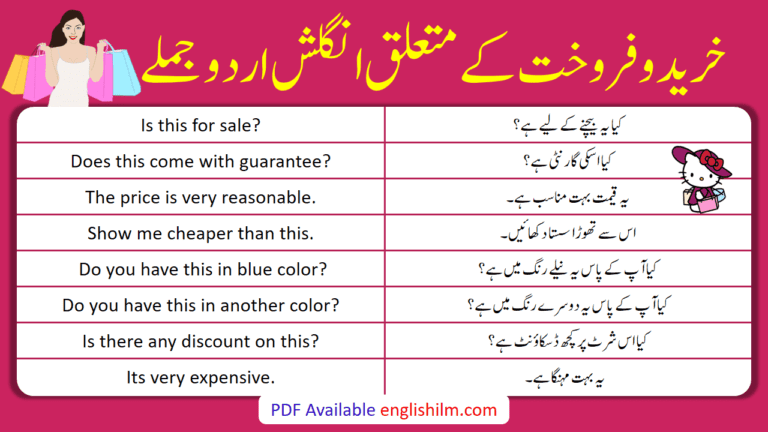In everyday English, people do not always use long forms of words. Instead, they make short forms by joining two words together. These short forms are called contractions. Contractions make speaking and writing more natural, easy, and quick. If you want to improve your English, learning important contractions will help you sound more fluent.
What are Contractions?
Contractions are short forms of words made by combining two words into one. An apostrophe (’) is used to show missing letters.
Examples:
- I am → I’m
- Do not → Don’t
Contractions are used in speaking, casual writing, and daily conversation.
Why are Contractions Important?
They make speech shorter and faster.
They help in natural conversations.
They are used in movies, songs, and daily talk.
Common Contractions in English
Here is a table of important contractions with their full form and contracted form:
| Full Form | Contraction | Example Sentence |
|---|---|---|
| I am | I’m | I’m happy today. |
| You are | You’re | You’re my friend. |
| He is | He’s | He’s a good boy. |
| She is | She’s | She’s my sister. |
| It is | It’s | It’s very hot. |
| We are | We’re | We’re going home. |
| They are | They’re | They’re in school. |
| Do not | Don’t | Don’t be late. |
| Does not | Doesn’t | He doesn’t like tea. |
| Did not | Didn’t | I didn’t see him. |
| Cannot | Can’t | I can’t swim. |
| Will not | Won’t | She won’t come today. |
| Would not | Wouldn’t | I wouldn’t lie to you. |
| Should not | Shouldn’t | You shouldn’t worry. |
| Could not | Couldn’t | We couldn’t find the book. |
| I will | I’ll | I’ll call you tomorrow. |
| You will | You’ll | You’ll enjoy the movie. |
| He will | He’ll | He’ll win the game. |
| She will | She’ll | She’ll help us. |
| We will | We’ll | We’ll study together. |
| They will | They’ll | They’ll meet us soon. |
| I have | I’ve | I’ve done my homework. |
| You have | You’ve | You’ve got a gift. |
| We have | We’ve | We’ve finished lunch. |
| They have | They’ve | They’ve bought a car. |
| Let us | Let’s | Let’s go outside. |
| That is | That’s | That’s my house. |
| There is | There’s | There’s a book on the table. |
| Who is | Who’s | Who’s knocking at the door? |
| What is | What’s | What’s your name? |
| Where is | Where’s | Where’s my phone? |
| When is | When’s | When’s the exam? |
| Why is | Why’s | Why’s he late? |
| How is | How’s | How’s your family? |

Complete List of Contractions and Their Types
1. Be-verbs Contractions
| Full Form | Contraction | Example |
|---|---|---|
| I am | I’m | I’m ready. |
| You are | You’re | You’re my friend. |
| He is | He’s | He’s at school. |
| She is | She’s | She’s happy. |
| It is | It’s | It’s raining. |
| We are | We’re | We’re students. |
| They are | They’re | They’re busy. |
2. Negative Contractions (-n’t forms)
| Full Form | Contraction | Example |
|---|---|---|
| Do not | Don’t | Don’t be late. |
| Does not | Doesn’t | He doesn’t care. |
| Did not | Didn’t | I didn’t know. |
| Cannot | Can’t | I can’t swim. |
| Could not | Couldn’t | We couldn’t go. |
| Should not | Shouldn’t | You shouldn’t lie. |
| Would not | Wouldn’t | I wouldn’t do that. |
| Will not | Won’t | She won’t come. |
| Was not | Wasn’t | It wasn’t easy. |
| Were not | Weren’t | They weren’t here. |
| Is not | Isn’t | This isn’t mine. |
| Are not | Aren’t | We aren’t late. |
| Has not | Hasn’t | He hasn’t called. |
| Have not | Haven’t | I haven’t seen it. |
| Had not | Hadn’t | I hadn’t finished. |
| Might not | Mightn’t* | He mightn’t agree. (rare, UK) |
| Must not | Mustn’t | You mustn’t smoke. |

3. Will / Would Contractions
| Full Form | Contraction | Example |
|---|---|---|
| I will | I’ll | I’ll call you. |
| You will | You’ll | You’ll enjoy it. |
| He will | He’ll | He’ll arrive soon. |
| She will | She’ll | She’ll help us. |
| It will | It’ll | It’ll be fine. |
| We will | We’ll | We’ll join later. |
| They will | They’ll | They’ll win the match. |
| I would | I’d | I’d like some tea. |
| You would | You’d | You’d enjoy this. |
| He would | He’d | He’d never lie. |
| She would | She’d | She’d be happy. |
| It would | It’d | It’d be hard. |
| We would | We’d | We’d better go. |
| They would | They’d | They’d love it. |
4. Have / Has / Had Contractions
| Full Form | Contraction | Example |
|---|---|---|
| I have | I’ve | I’ve finished. |
| You have | You’ve | You’ve done well. |
| We have | We’ve | We’ve been busy. |
| They have | They’ve | They’ve arrived. |
| He has | He’s | He’s gone home. |
| She has | She’s | She’s completed it. |
| It has | It’s | It’s been nice. |
| I had | I’d | I’d already eaten. |
| You had | You’d | You’d been waiting. |
| We had | We’d | We’d finished work. |
| They had | They’d | They’d gone early. |
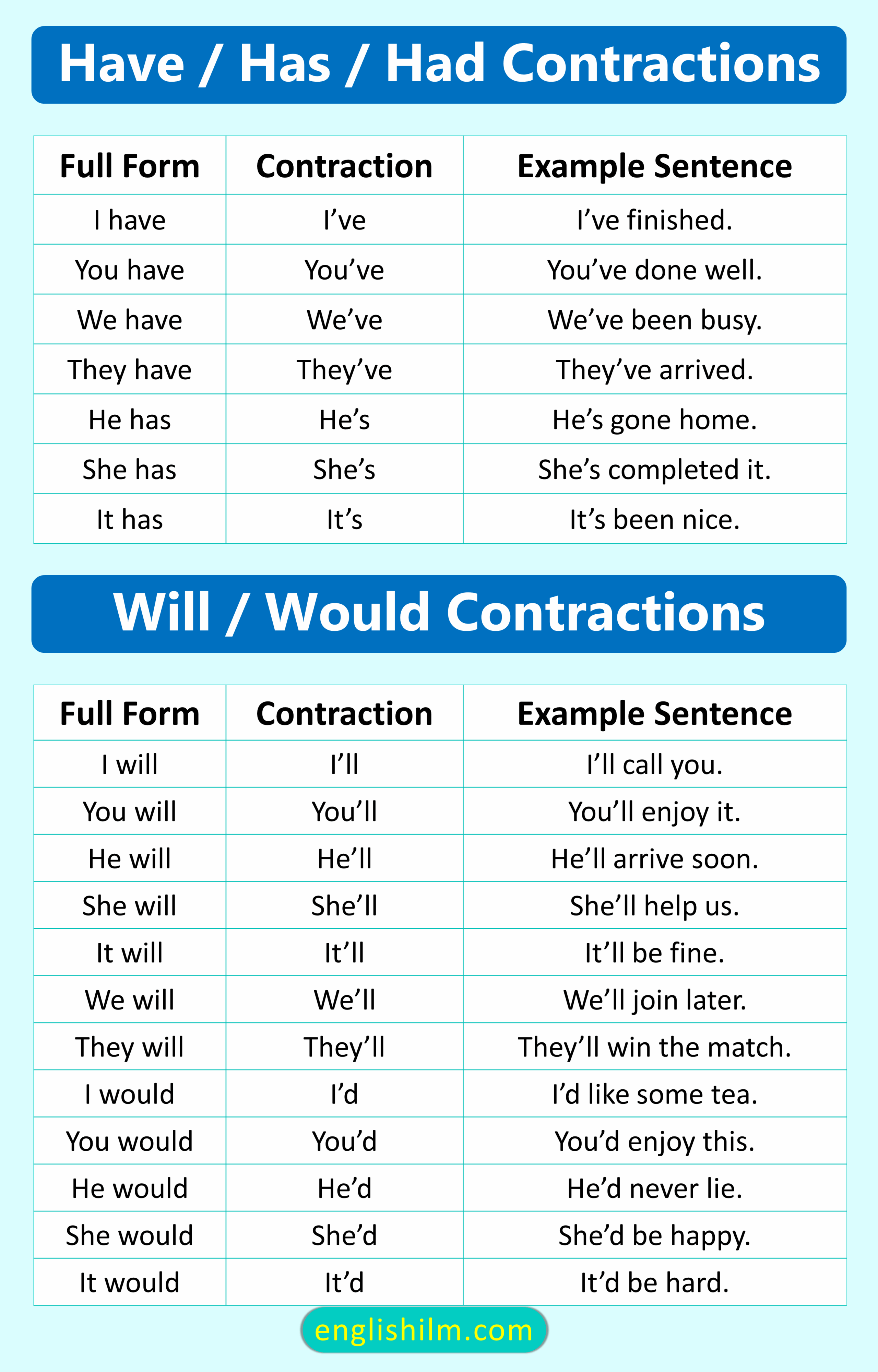
5. Question Word Contractions (WH-words)
| Full Form | Contraction | Example |
|---|---|---|
| Who is | Who’s | Who’s there? |
| What is | What’s | What’s your name? |
| Where is | Where’s | Where’s my phone? |
| When is | When’s | When’s the party? |
| Why is | Why’s | Why’s he late? |
| How is | How’s | How’s your family? |
| Who will | Who’ll | Who’ll help me? |
| What will | What’ll | What’ll happen next? |
| Where will | Where’ll | Where’ll we meet? |
6. Other Useful Contractions
| Full Form | Contraction | Example |
|---|---|---|
| Let us | Let’s | Let’s eat. |
| That is | That’s | That’s true. |
| There is | There’s | There’s a dog outside. |
| There has | There’s | There’s been a mistake. |
| Here is | Here’s | Here’s your book. |
| How did | How’d | How’d you know? |
| What have | What’ve | What’ve you done? |
| Could have | Could’ve | I could’ve helped. |
| Should have | Should’ve | You should’ve called. |
| Would have | Would’ve | I would’ve told you. |
| Might have | Might’ve | She might’ve left. |
| Must have | Must’ve | He must’ve forgotten. |
7. Informal & Regional Contractions (Casual Speech)
| Full Form | Contraction | Example |
|---|---|---|
| Am not / Is not / Are not | Ain’t | I ain’t ready. |
| You all | Y’all | Y’all come here. |
| Want to | Wanna | I wanna play. |
| Going to | Gonna | I’m gonna eat. |
| Got to | Gotta | I gotta go now. |
| Kind of | Kinda | She’s kinda tired. |
| Give me | Gimme | Gimme a chance. |
| Let me | Lemme | Lemme help you. |
| What do you | Whatcha | Whatcha doing? |
| Don’t you | Doncha | Doncha know? |
Quick Tips to Remember
- Always use apostrophe (’) in contractions.
- Use contractions in speaking and casual writing.
- Avoid contractions in formal writing.
FAQs on Contractions in English
Q1: What are contractions in English?
A: Contractions are short forms of two words joined together with an apostrophe. Example: Do not → Don’t.
Q2: Why are contractions important in English?
A: Contractions make English sound natural, faster, and easier. They are common in daily conversation, movies, and songs.
Q3: Can I use contractions in formal writing?
A: No, contractions are usually not used in formal writing such as reports, essays, or official letters. They are best for speaking and informal writing.
Q4: What are the most common contractions in English?
A: Some common contractions are: I’m (I am), You’re (You are), Don’t (Do not), Can’t (Cannot), It’s (It is), They’re (They are).
Q5: How can I practice using contractions?
A: You can practice contractions by speaking daily sentences, reading stories or dialogues, and writing short conversations using them.
Learning important contractions will make your English more natural, friendly, and fluent. They are simple to understand and very common in daily life English. Practice using them in your conversations and writing, and soon you will feel more confident.
Read More

